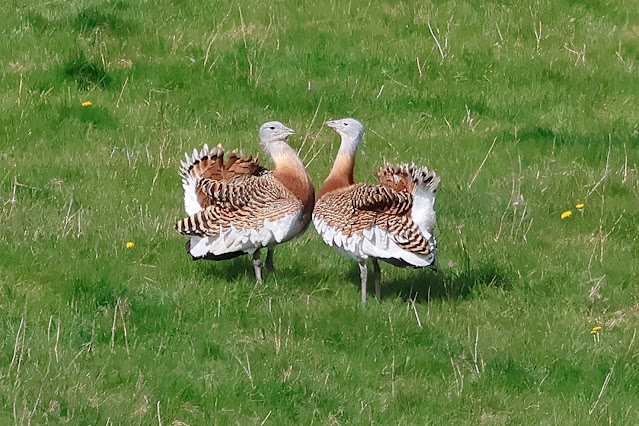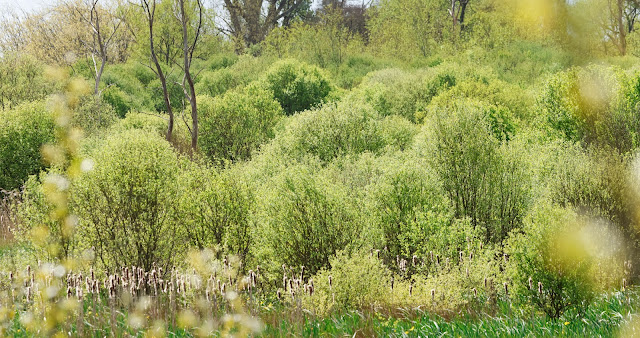Last month while watching the Stone Curlews at RSPB Winterbourne I was talking to a birder who volunteered for the Great Bustard Group on Salisbury Plain, he told me where to see them, but warned of some bad roads with deep potholes. However it was possible to go on a tour with the Group who would transport you in Land Rover Defenders. This seemed a better idea and a tour was booked.
Fortunately Tuesday dawned with sunshine and calmer winds after the heavy rain and gale force winds the day before. We were to meet at the Village Hall in Enford, a village on the outskirts of Amesbury. While waiting for the tour leaders to arrive a pair of Red Kite provided entertainment above the playing fields.
Globally, the Great Bustard is at risk of extinction.
Classed as Vulnerable on the IUCN Red List of Globally Threatened Species, it’s
estimated that there are fewer than 35,000 Great Bustards left in the wild.
Created in 1998, the Great Bustard Group is on a mission to
save this beautiful bird, reintroducing it to the wild and campaigning for
increased protection from man-made and natural threats
The Great Bustard was a fixture in the UK until the mid
1800’s, when the species became a target for Victorian trophy hunters, and its
natural habitat was destroyed by farmers.
The UK remains very hospitable to the Great Bustard, with
Wiltshire’s rolling downland and arable fields ideal conditions for the bird to
thrive. As such the Great Bustard Group
was formed in 1998 to explore the possibility of reintroducing the Great
Bustard to the UK. A feasibility study demonstrated that the UK offers suitable
conditions for Great Bustards. It concluded the reintroduction of the bustard
would add to the rich and vibrant ecosystem without harming existing indigenous
bird species.
In 2004, the Department for the Environment, Food and Rural
Affairs (DEFRA) issued a 10-year trial licence for a reintroduction program. The
first release was in 2004, and they continued until 2019. This has established
a population of over 100 Bustards in the UK, and the population is now breeding
at a level to be self-sufficient.
We left the village hall and drove up on to Salisbury Plain. The road was in very poor condition and I was pleased I had resisted the urge to visit on my own. We passed through a farm and then out on to the open Plain with arable fields around us. Heading up a hill we were able to get the first views of Great Bustard, very similar to the ones I spotted in Portugal a few years ago. This a male.
A little closer, the sun bringing out the rich reddish buff colours.
Another male was going through their elaborate display, but sadly a long way off.
As we headed down the hill once more two males were seen in the field squaring up to each other.
Using their strong necks and bills the two males started to fight, we were told that this could end in death or at least bad injury to both birds.
Backing off and going eye to eye.
The Great Bustard (Otis tarda) is the largest member of the
26 species strong family of bustards. The Great Bustard is believed to be the
heaviest flying bird on earth. The heaviest verified specimen, collected in
Manchuria, was about 21kg.
Huge, heavily built and robust, but stately in appearance,
adult male bustards can be identified by their bulging neck, heavy chest and
characteristically cocked tail. Their
shape is similar to a large goose, but the bustard is much larger with
considerably longer legs and a straighter neck.
The two Great Bustards were attracting the attention of the Red Kites, three birds were around, maybe they were expecting some blood or opportunity.
Males develop a band of russet coloured feathers on their
lower neck and breast, which becomes wider and brighter as they get older. They
grow large impressive bold white moustache whiskers (20cm long) and the colours
on their back and the tail become more vivid.
We were told that this was behaviour very rarely seen, the two males fighting it out is unusual, they will normally display at the Lek and leave each other alone, leaving it to the females to choose their most suitable partner. These birds, we were told, were of Spanish origin, originally Russian stock birds were released, but lately, for obvious reasons, it is birds from Spain.
We were taken to the visitor centre and shown some stuffed Bustards that really brought home the size of these birds. On the journey back the two males were nowhere to be seen. Other birds seen as we drove across the Plain were Yellowhammer, Corn Bunting and Red-legged Partridges.
From Wiltshire I headed back into Hampshire and Fishlake Meadows. I thought it was a chance to find some more summer migrants. In the car park an Orange Tip flew through, another species I was hoping to catch up with.
Walking along the canal path once again there were plenty of singing Chiffchaffs.
A little further another Fishlake specialty, the Cetti's Warbler.
I saw Peacock, and Brimstone, but little else, distant Swallows were above the open water, and both Sedge and Reed Warblers singing from the reeds, but not showing, probably due to the now quite blustery wind.
The path to the centre screens was still flooded, but not as bad as a few weeks ago. What hadn't changed was the amount of birds seen from the screens. The highlight being four fighting Little Grebes.
As I walked back there was a movement of Sand and House Martins.
Another Cetti's Warbler showed well along the centre path.
Back on the canal path I was taken by the beauty of the emerging leaves on the trees across the meadows.
Several Orange Tips flew past me and in the sunshine did not stop, however when the sun went in the butterflies were happy to stop and that gave me a chance. Here a male.
With the wings slightly open and viewed from the side you get the chance to see the beautiful patterned underwing and the orange tips that give the butterfly its name.
Then when the sun came out the wings were opened.
There were several damselflies along the canal path, this Large Red Damselfly the only one to settle.
With the sun going in a female Orange Tip settled, once again showing off the beautiful patterned underwing.
Here the black tips on the upper side as opposed to the orange tips of the male.
Just before I reached the car park I flushed a male Bullfinch from having a bath in a stream below. I couldn't get a clear view of the male, but the female had obviously been doing the same and she was just visible through the branches.
The Great Bustard Tour was a great experience and well worth taking, the money (£2%) goes towards the work the Group are doing, so that can't be bad. Fishlake, once again, was Fishlake!





































No comments:
Post a Comment